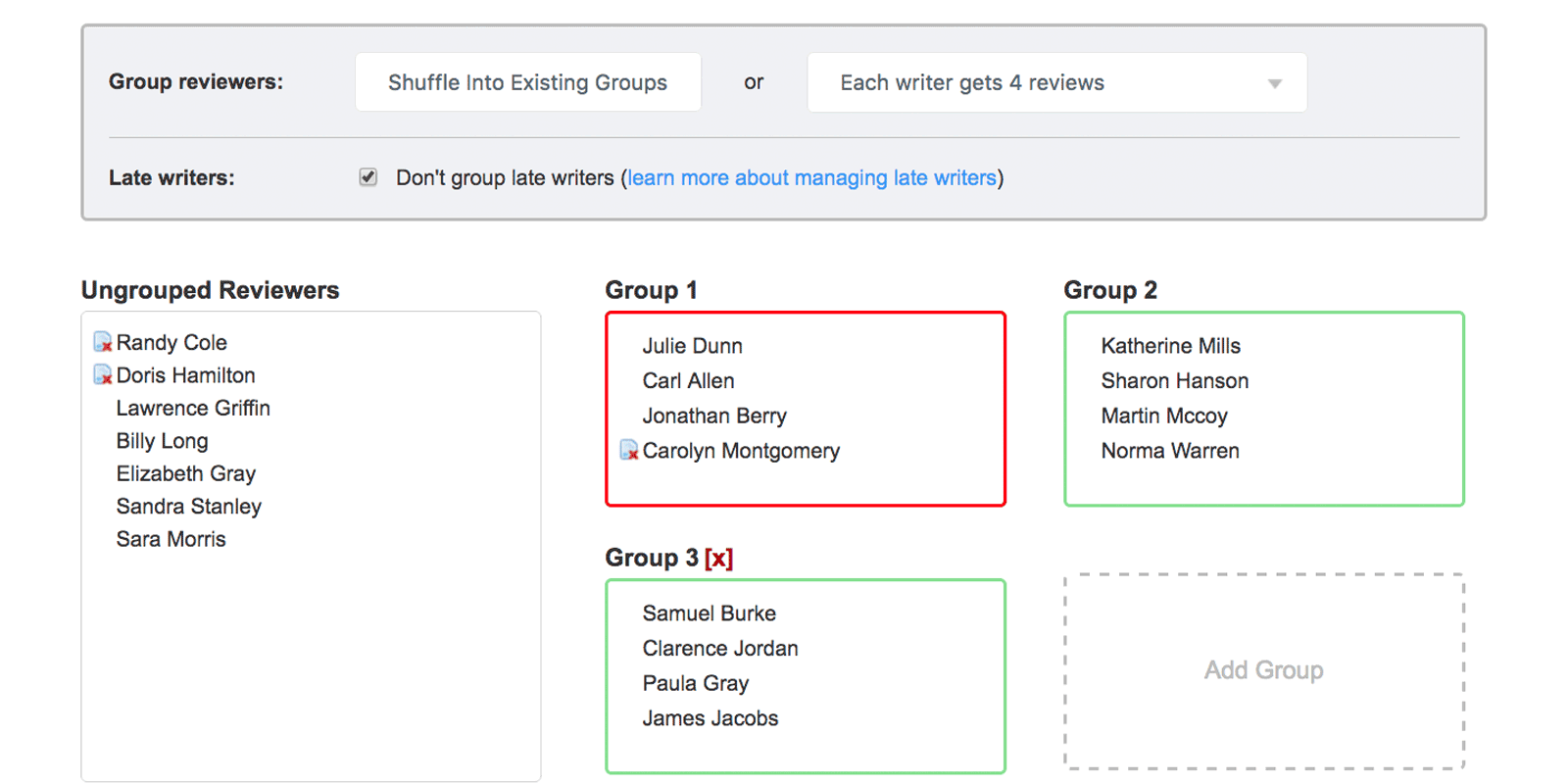This post is a part of the series Challenges and Opportunities in Peer Learning.
In the first post on the “no pain, no gain” aspect of learning, we explained why student disengagement in peer learning is a key problem. Developing new skills as thinkers, readers, writers, and reviewers take practice. Yet, almost nobody loves practice. Failure to practice is failure to learn. In this second post, we discuss strategies for keeping everyone engaged.
Part 2: Keeping Everyone Engaged
The opportunity in peer learning is to help students improve by making little adjustments in their own approach based on exposure to how peers do it. An equally powerful second opportunity is helping students apply criteria to their work, building meta-awareness. Imitation is not only the highest form of flattery, but it is also a good way to learn. Thinking along with peers—and, by applying criteria, with the teacher—are both great learning habits!
The other of driver of success in peer learning is routine deliberate practice; it’s a method of getting students to write more days than they don’t. More is better. More often is better. Less often or inconsistent practice can actually do more harm than good.
In a class where peer learning is the effective dose, the most basic indicator of improvement is engagement in giving and using helpful feedback. We don’t simply let students off the hook because they missed feedback. We hold them accountable for participation because we know that it’s the best way they can improve.
Want to keep everybody in your class engaged? Here are five tips to supercharge peer learning.
Strategy: Value engagement.
The only way to get more of what you want is to ask for it. And, it’s just as important to reward the behavior you seek if you want to see more of it. If you want students to be engaged in peer learning, you can place value on their work in several ways:
- Praise engagement. Each time you call out a student for good work, you are showing the class what you value. Take two minutes of every class and praise the behaviors that lead to learning.
- Celebrate model drafts and helpful comments.
- On the side or from the front of the room, thank reviewers who gave a lot of helpful comments (and endorse those comments).
- Show your appreciation for students who are consistently helpful week-to-week—written or verbal compliments, bonus points, even a treat.
- Make engagement count. Put the points on what you value. Students see the value you place on process versus product in grades. Or, to use Asao Inoue’s formulation, decide how labor-failure and quality-failure play out in your course. Nothing you can say or do speaks louder than course grade calculation. Keep it simple with completion points week-to-week and a periodic quality assessment.
Strategy: Justify the value you place on engagement.
Explaining why you value engagement in peer learning is critical for helping students understand that it is not busy work, that it is the work they need to be busy doing to learn. Persuade students that your preoccupation with their peer learning effort comes from expertise:
- Assign readings and videos that lay the foundation, such as our four student resources for upping the review and revision game. The University of Minnesota Writing Studies Department also has helpful videos on peer review and commenting strategies.
- Share or summarize the research literature on peer learning.Take 5 minutes to summarize the methodology and results of an empirical study on the power of giving helpful feedback.
- Discuss your own classroom-based research using the data in Eli.
- Share a story. You’ve had students who
- made unexpected leaps as a writer because of their engagement in peer learning;
- were strong writers but stalled because they didn’t learn to articulate what problems they saw in drafts and offer suggestions for improvement;
- failed because they missed too much of the process and their final draft didn’t meet expectations.
Be confidential. Or be bold: Ask your former student for a picture and a quote to use when you share their story, or invite them to be a guest speaker and tell their own story. Or, ask your current students to share their stories of learning from peers.
Strategy: Don’t leave late writers behind.
A new Eli feature added in summer 2016 lets instructors exclude late writers while forming groups for peer review. It is an enormous time-saving convenience. Peer learning requires on-pace participation, and that little check box makes it easy to leave late writers out.

And, there are good reasons to do so. Experiencing deadlines is good prep for everything from jobs to taxes. Adding late writers to groups who are further along is disruptive. Making feedback contingent on timeliness encourages writers to understand how their actions affect others.
But, there are also good reasons to help late writers get back on pace. Without giving and using feedback, students are unlikely to improve. Extending a grace period for late writers to join a group gives them a chance to catch up.

In the online professional development workshops that I host each month, I describe managing late writers with the metaphor of driving a bus. At the appointed time, I drive by and pick up all prepared writers. These students get prime seats in that they are grouped with other prepared writers and get the most time to give feedback. Again, at agreed upon times, I swing back by and pick up late writers. Late writers work with late writers so they are at each other’s mercy to give feedback within the deadline. For motivated students, the contrast in the quality of feedback they receive when they are prepared versus when they are late is enough to convince them to be prepared next time. For other students, tardiness is a pattern, and the costs aren’t high enough to change their behavior. This bus driving approach gives late writers a path forward, and it minimizes how much extra effort it takes me to manage group formation.
Strategy: Make growth the measure of success.
In our student module “Rethinking and Revising,” we explain that managing the emotional work of revision takes both Dweck’s growth mindset and Duckworth’s concept of grit. Dweck’s research underscores that students’ beliefs about whether their performance is tied to inborn talent (a fixed mindset) or practice (a growth mindset) affects how much they learn. In a fixed mindset, everything’s busy work. If students believe they are born smart or not, they expect the outcome is rigged by their genetics.
Given how many students think of themselves as “not good writers,” at least some disengagement comes from a lack of faith in the value of giving and receiving feedback as part of routine, deliberate practice. Without that faith in practice, there’s no reason for students to grit it out, to borrow Duckworth’s term.
Duckworth’s notion of “grit” also plays out in a different way for students who shut-down emotionally after receiving negative feedback or poor grades. Using feedback to improve requires a whole new set of beliefs and practices to help them be resilient and ultimately successful.
Because students’ beliefs about their capacity to learn affects their effort at learning, we have to continuously address their beliefs about how learning happens. Explicitly rewarding effort and celebrating growth are two ways to address underlying reasons for student engagement, and the table below offers suggestions.
| Strategies for Rewarding Effort | Strategies for Celebrating Growth |
|---|---|
|
|
Strategy: Assume responsibility for making peer learning effective.
In addition to trying to dislodge students’ fixed mindsets and to encourage resilience, remember that students have no reason to trust us on the value of peer learning, even when we cite excellent research.
Student will believe what they experience. In an interview earlier this year, Bob Yagelski explained how he structures peer learning to emphasize inquiry, a goal students don’t understand and don’t believe in at the beginning of the course. His role then is to create an effective peer learning experience and guide students in recognizing the power of inquiry through reflection:
In my classes, I try to make students understand that when I have them engaged in any sort of peer review—no matter how formal or informal—they’re actually exploring the subject matter along with the writer and contributing to that shared process of inquiry. I do this in part through practice and reflection. It isn’t something students learn simply by listening to me. They have to do it, then reflect on it. My role is to guide them in that process of practice and reflection, constantly naming what they’re doing and providing opportunities for additional practice and reflection. It’s a version of Dewey’s experiential learning. (emphasis ours)
There’s so much instructors can do to make sure peer learning is effective: from the tasks we design to the ways we monitor student engagement to the ways we count students’ labor. We can’t eliminate students’ disengagement, but we can provide a narrative and a structure that helps them understand the costs of missing out on giving and using feedback.
Bottom-line: Create FOMO (fear of missing out) around peer learning.
In a feedback-rich classrooms, students will notice when their peers are doing well. They will especially notice when they improve because they are getting good feedback. When they do, they want in. And when the get used to getting good feedback, they will see the value of giving it as well. With Eli, this can all happen fast. Even in a single day.
Student disengagement is a serious problem if we’ve already decided that deliberate practice in a small group is the best method of learning. That means we need to do what it takes to make sure students are getting the lowest effective dose of the intervention that will increase their chances of success.
We can’t back away from deliberate practice—the best thing we can offer—because they don’t like it or don’t do it. We’ve got to design the practice schedule so they have the best chance of liking it and the best chance of doing it. We’ve got to create a learning environment where they experience the value of that practice through helpful feedback. And, if students don’t do the peer learning activities, it is not just an inconvenience for the class that merits a few docked points. It’s a big red flag that students’ beliefs and behaviors will not lead to learning.
Read Part 1 of No Pain, No Gain, Student Disengagement
References
- Dweck, Carol S. 2006. Mindset: The New Psychology of Success. 1st ed. New York: Random House.
- Dweck, Carol. “The Power of Believing That You Can Improve.” TedTalk. November 2014. 10:20.
- Duckworth, Angela. 2016. Grit: The Power of Passion and Perseverance. New York: Scribner.
- Duckworth, Angela Lee. “The Key to Success? Grit.” TedTalk. May 2013. 6:12.
- Inoue, Asao B. (2014). Theorizing failure in writing assessments. Research in the Teaching of English, 48(3), 329-351.

